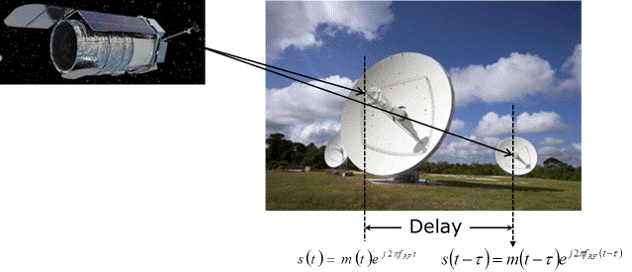DEFINITION
WFIRST is a space telescope scheduled to be positioned at the L2 Sun-Earth Lagrangian point, between near-Earth and Deep Space (about 1.5 million km or 0.01 au from the Earth) in 2025.

Because of the significant range loss to distant near-Earth and deep space targets, large aperture antennas, such as reflectors, are needed. Traditionally, large single antennas are employed but they carry with them the potential for a single point failure, limited operational flexibility, and the high cost of custom vs COTs hardware.
Receive antenna arraying is not new. Decades ago, when the high gain antenna on Galileo failed to deploy successfully, JPL and NASA saved the mission by receive arraying continentally separated reflector antennas, albeit at very low data rates.
Despite this success, the arraying method used then as well as state-of-the-art methods used now in radio astronomy are inadequate to address in real-time new generation spacecraft signals with much higher downlink frequencies (Ka-band) and very high bandwidths.
This is in large part because of
- The difficulty of simultaneously obtaining the rapidly-changing, very fine time delay resolution (< 1.0ps) needed for Ka-band beam formation and very large differential time delay (~400ns) needed to time align very wideband signals from widely separated antennas
- The large continually changing differential Doppler
- Differential tropospheric effects encountered by signals arriving through different atmosphere at each of the widely separated reflectors
Our innovative widely spaced arraying algorithms, the feasibility of realizing real-time arraying bandwidths of more than 600MHz, and the availability of antennas designed with features optimal for arraying enable us to offer flexible arraying solutions for challenging NEN missions.
After forming Specialized Arrays, we have developed new “mixed domain” methods from first principals that enable wider spacing and bandwidths, higher frequencies, with emphasis on near-Earth vs Deep Space missions. With the explosive growth in DSP/FPGA technology, our advanced algorithms can now be implemented.
Along with the hardware, we bring arraying algorithms that obtain fast optimum solutions irrespective of signal characteristics. This gives our design the ability to process virtually any signals from other bands with equal or lower bandwidth requirements, even in a co-channel interference environment (such as cross pol in a polarization reuse application).
Our experience on TxACE as system architects and Principal Investigators, during which we designed, guided, tested and demonstrated the system has uniquely prepared us to lead this effort – another NASA cutting edge program leading to a wideband Ka-band array at Punta Arenas.


